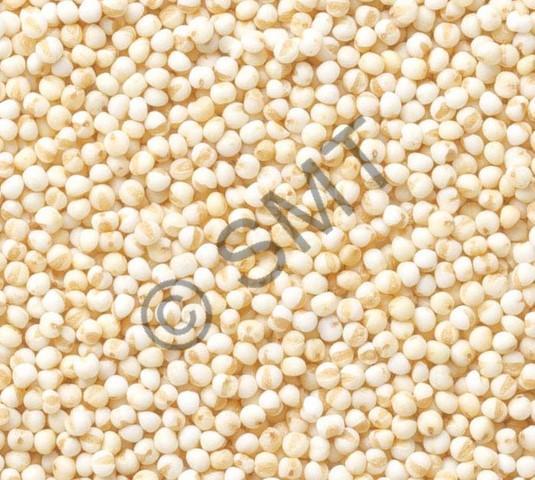Little Millet
| Little millet, scientifically known as Panicum sumatrense, is a small-grained cereal crop that has been grown and consumed for centuries in parts of Asia and Africa. Its nutritional profile is impressive, containing high levels of protein, dietary fiber, iron, calcium, and magnesium. It is also gluten-free and rich in antioxidants. Little millet has numerous health benefits such as improving digestion, reducing inflammation, lowering cholesterol levels, aiding in weight loss, and managing diabetes. Due to its low glycemic index value compared to other grains like rice or wheat, it can also stabilize blood sugar levels. Furthermore, the cultivation of little millet promotes sustainable agriculture practices as it requires minimal amounts of water and fertilizer while providing food security for farmers and communities. Its versatility makes it a suitable ingredient for various dishes such as porridge, pilaf or blended into flour for baking products like bread or cakes. |
0
People watching this product now!
Category: Millets
Cooking Method & Health Benefits
| When it comes to cooking little millet, it is important to note that it has a higher starch content than other types of millets. This makes it ideal for cooking as a rice substitute and an excellent option for those looking to reduce their carbohydrate intake. To prepare this nutritious grain, simply rinse the millet under cold water and discard any debris or foreign matter. Then, soak the grains in water for at least 15 minutes before draining excess water and adding the millet to a pot with a 2:1 ratio of liquid to grain. Bring the mixture to a boil before reducing heat and allowing it simmer for around 15-20 minutes until fully cooked. Once done, remove from heat and let sit covered for at least five minutes before fluffing with a fork and serving as desired. Whether being used in salads or curries, little millet adds nutritional value and versatility to any dish. | Little millet, also known as kutki or samai, is a nutritious grain that offers several health benefits. It is gluten-free and rich in protein, fiber, vitamins, and minerals such as iron, magnesium, calcium, and zinc. Little millet contains phytochemicals that have antioxidant properties and aid in reducing the risk of chronic diseases such as diabetes and cancer. Its high fiber content facilitates digestion and prevents gastrointestinal disorders like constipation. Regular consumption of little millet can help to maintain healthy cholesterol levels thus contributing to better cardiovascular health. The presence of essential amino acids including tryptophan in this grain promote peaceful sleep patterns, which helps alleviate stress and anxiety levels. Furthermore, this nutty-flavored grain is incredibly versatile making it an excellent ingredient for myriad recipes such as salads, porridges, soups or stews providing both culinary pleasure and nutritional benefits to consumers. |
Related products
Amaranth Millet
| Amaranth Millet, also known as Rajgira or Ramdana, is a grain that has been consumed for centuries in various parts of the world, particularly in Africa, India, and South America. This gluten-free and highly nutritious grain is loaded with essential vitamins such as B and C that are crucial for overall health. It also contains high levels of minerals like iron, magnesium, and calcium which are essential for the body's functions such as muscle function and bone development. Amaranth Millet is used to make various dishes like porridge, soups, breads and even candy-like sweets in some cultures, making it a versatile food item. Moreover, research suggests that this grain may have therapeutic properties such as reducing cholesterol levels and blood pressure while also aiding digestion. Overall, Amaranth Millet serves as an excellent source of healthy carbohydrates providing numerous health benefits while being a delicious addition to meals. |
Barnyard Millet
| Barnyard millet, also known as Echinochloa frumentacea, is a cereal grain that has been traditionally used in India and other parts of Asia for centuries. This gluten-free millet is a good source of nutrients like protein, dietary fiber, calcium, and iron. It also contains antioxidants that may help reduce the risk of chronic diseases such as cancer and cardiovascular disease. Barnyard millet is easy to digest due to its high soluble fiber content and can be incorporated into a variety of dishes like porridges, pilafs, and flatbreads. Its unique taste, texture, and health benefits make it an ideal choice for people looking for nutritious alternatives to wheat or rice-based foods. Additionally, its drought-resistant properties make it an important crop in regions with limited access to water resources. |
Buck Wheat
| Buckwheat, also known as "kasha," is a highly nutritious food that has been gaining popularity in recent years due to its numerous health benefits. Despite its name, buckwheat is not related to wheat and is actually a fruit seed that is closely related to rhubarb and sorrel. It is gluten-free, making it an excellent alternative for those with celiac disease or gluten intolerance. Buckwheat contains high levels of fiber, protein, and essential amino acids, which are necessary for muscle growth and tissue repair. Additionally, buckwheat contains rutin, a flavonoid that has been shown to lower blood pressure and improve circulation. Buckwheat can be enjoyed in various forms such as groats, flour, pasta or used as a substitute for rice in dishes like pilafs or stir-fries. Its versatility combined with its health benefits make buckwheat an excellent addition to any diet. |
Finger Millet / Ragi Whole
| Finger millet, also known as Ragi, is a nutritious cereal grain that has been cultivated for thousands of years in Africa and Asia. It is a staple food crop in many regions due to its exceptional nutritional content which includes high amounts of dietary fiber, calcium, and iron. Finger millet has low glycemic index making it an ideal food for diabetic patients and people with gluten intolerance. It is rich in antioxidants like phenolics and flavonoids which have been shown to offer several health benefits including anti-inflammatory effects, immune system stimulation, and protection against certain types of cancer. Furthermore, finger millet has gained popularity among athletes due to its high concentration of amino acids like leucine, isoleucine, and valine which are essential for muscle growth, repair and recovery. Due to its impressive health benefits and versatility finger millet can be consumed in various forms ranging from flour for bread-making, snacks or porridge to beer brewing or animal feed production. |
Foxtail Millet
| Foxtail millets are small, drought-resistant cereal grains that have gained popularity in recent years due to their nutritional benefits. In addition to being gluten-free, foxtail millets are rich in fiber, protein, and essential nutrients like iron and zinc. This makes them an excellent choice for individuals seeking a healthy diet or who suffer from allergies or celiac disease. Foxtail millets are versatile and can be used in a variety of dishes such as porridges, pilafs, salads, and baked goods. They also serve as a staple food in many parts of the world and are an essential source of nutrition for millions of people every day. With their high nutritional value and adaptability in cooking, it is no wonder that foxtail millets are becoming increasingly popular in the health food market worldwide. |
Kodo Millet
| Kodo Millet, also known as cow grass or Paspalum scrobiculatum, is an ancient cereal crop that originated from India and has been cultivated for thousands of years. It is a small-grained cereal that is packed with essential nutrients such as protein, fiber, vitamins B1 and B3, calcium, iron, and zinc. Kodo Millet is a hardy crop that can grow in poor soil conditions and does not require heavy rainfall to thrive. Due to its rich nutrition value and its gluten-free nature, it has gained popularity among health-conscious consumers globally. Moreover, Kodo Millet provides an excellent option for people who are allergic to wheat or gluten intolerance. The versatility in cooking makes this cereal easy to incorporate into daily diets by using it for porridge or rice dishes. With all these benefits combined with sustainable agriculture practices and economic benefits for small farmers growing the crop organically; Kodo millet has become an increasingly valuable resource for the food industry and the agricultural sector. |
Pearl Millet
| Pearl millet, also known as bajra in India, is a popular grain crop grown in several regions of the world due to its drought-resistant properties. With a high protein content, pearl millet has become an essential source of nutrition for people who rely on it as a staple food. This hardy cereal crop thrives during hot summer months and hence is cultivated widely across Africa, Asia, and Pakistan. Along with being rich in dietary fiber and essential minerals like iron and phosphorus, pearl millet is also gluten-free making it an excellent alternative for individuals with gluten sensitivity. Additionally, researchers have found that pearl millet contains phytochemicals such as lignans and phytosterols that may have powerful health benefits ranging from reducing inflammation to combating chronic diseases such as cancer. As climate change threatens global food security by altering precipitation patterns around the world, pearl millet's adaptability to harsh weather conditions makes it a promising solution to ensure sustainable food production. |
Proso Millet
| Proso millet, also known as Panicum miliaceum, is a versatile grain that is increasing in popularity due to its nutritional content and ease of cultivation. Originating from China over 8,000 years ago, proso millet was one of the earliest domesticated crops and has since spread throughout the world, adapting well to different climates and soil types. This gluten-free grain is high in protein, fiber, and essential nutrients such as iron and phosphorus making it an ideal food for those with dietary restrictions or seeking plant-based protein sources. Additionally, proso millet has a low glycemic index which may provide health benefits for individuals with diabetes or metabolic disorders. Proso millet can be used as a substitute for rice in many dishes and can also be ground into flour for baking applications. As interest in alternative grains continues to grow among consumers, proso millet is likely to become an important player in the global food market. |
Quinoa Millet
| Quinoa and millet are two popular ancient grains that have gained significant attention in recent years due to their numerous health benefits. Quinoa, a gluten-free pseudocereal, is known for its high protein content and essential amino acid profile making it an ideal addition to the diet of vegetarians and vegans. Additionally, quinoa is rich in fiber, vitamins, minerals, antioxidants and has also been linked with several health benefits including improving blood sugar control and reducing inflammation. Millet, on the other hand, is a small-seeded grass commonly grown in Africa and Asia. It's gluten-free and contains complex carbohydrates that release energy slowly providing prolonged satiety while maintaining stable blood sugar levels. Millet also boasts various nutrients including calcium, magnesium, phosphorus as well as fiber which aids in digestion. These nutrient-dense grains offer an excellent alternative to traditional staples such as wheat and rice encouraging diverse diets provision for optimal health through balanced nutrition. |
Sorghum Millet
| Sorghum millet, commonly known as jowar in India, is a staple food crop that has been grown for centuries across many parts of the world. This gluten-free grain has become increasingly popular over time due to its numerous health benefits and versatility in cooking. Sorghum millet is high in fiber, protein, and essential vitamins and minerals such as iron, zinc, and magnesium. Additionally, it has been found to have antioxidant properties that can help prevent chronic diseases such as diabetes and cardiovascular disease. With its ability to grow well in hot and dry climates, it has become an important crop for farmers around the world because of its resilience to climate change. Sorghum millet can be used for various purposes including making flour for baking breads or used as a whole grain in salads or side dishes offering a deliciously nutty flavor. |











